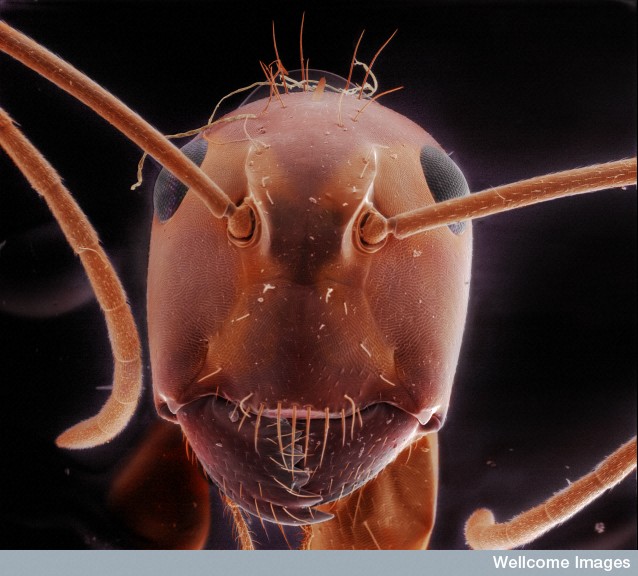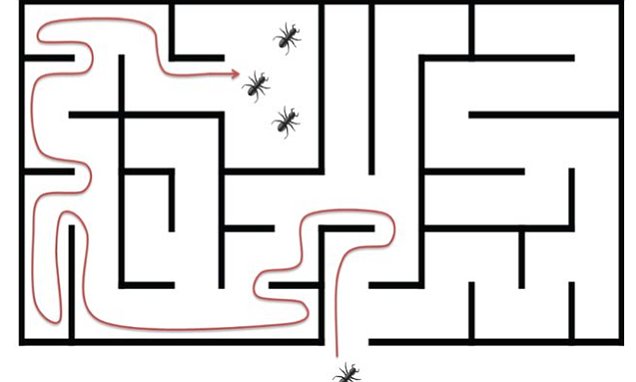Lefties
Behavioral lateralization is a significant field of study because it may provide insights into the initial origins of lateralization. Different and very diverse organisms show lateralization. The best known is handedness, a better (faster or more precise) performance or individual preference for use of a hand but it is not unique, many creatures, including humans, show a preference for one side over the other in movement or the senses. New Caledonian crows also have lateral preferences. Across the whole population, the crows seem to prefer to make tools from the left edges of leaves, which involves using the left-hand side of their bill. Of course, ants do not have hands nor bills but a tendency similar to handedness has been demonstrated in choosing the direction to turn when surveying a crevice.
Edmund Hunt is working toward his Ph.D. at the ant lab at Bristol University in England. Hunt, who trained as a physicist, has turned to ant colonies to explore how simple guidelines for behaving can create complex outcomes. In between science degrees, Hunt studied economics and worked in financial regulation, which is where he first began to think about collective animal behavior, something crucial in the stock exchange and other markets.

In a paper published in Biology Letters 1, Hunt and his coworkers studied rock ants, Temnothorax albipennis, a species that usually live in rocky crevices. When they need to find a new home, these insects explore unknown places, not unlike laboratory mazes. Groups of scouts crowd into various fissures until they eventually reach a quorum in one of them and choose it as their new home.

The experiments design was simple. Unknown nests were located with their entrance opposite to the actual nest. Exploring was encouraged by destroying the starting nest or increasing its light level. In one experiment, 5-15 scouting ants from eight colonies were observed while exploring a brand new nest. Groups of scouts turned left in 35 cases after entering the nest, and right in 19. The second experiment involved a maze with four branches and two decision points to see whether laterality in choice was sustained. From the second fork onwards, the ants opted left more often, 50 times compared with 30 right turns. This second experiment demonstrated that ants persist in incidental thigmotactic behavior (favoring a repeated choice of left-left or right-right). The ants also have a tendency to follow a wall, but when willing to step away from it, they show the leftist bias, something that was confirmed with the statistical analysis and it was strong enough to be significant at the population level.

It is possible that the preference to turn left when entering an unfamiliar site is actually useful to the ants in terms of their exploration of maze-like environments. It is well-known that the best way to search and exit from a maze is to turn the same direction at every bifurcation, the «wall-follower» technique. A second option is that it could help the explorer ants to group. Clusters of ants may fare better than a loner should they happen upon a predator since animals may obtain cover from nearby conspecifics. Herding together may also speed the process of reaching the vital number of exploring scouts in a particular crevice that tips the decision to establish there the colony nest. A third option is that their left eye may be better than the right for detecting predators. This is something that has been demonstrated in fish and lizards. A fourth option or maybe the explanation for those previous ones is that the underlying nervous system is not symmetrical and each brain side may be specialized for particular functions. Then, an asymmetry of the brain would correspond to an asymmetry in the senses and would reflect in an asymmetric behavior. A fifth option is that asymmetrical individuals coordinate better their behaviors as a group following a simple rule such as left bias.
Brain hemispheres differences were considered a unique human success from evolution, doubling cortical surface but lateralized brain function has been later found in many different animals, regardless of the overall brain size and complexity. There is now an increasing amount of evidence for sensory and motor asymmetries in the behavior of invertebrates, typically associated with asymmetries in their nervous system. The European honeybee (Apis mellifera) relies predominantly on its right eye for detecting objects whereas the common American cockroach (Periplaneta americana) has a bias for turning right in a Y-shaped tube and giant water bugs (Belostoma flumineum) mainly opt left in underwater T-mazes. A study of ladybirds (Coccinella septempunctata) found turning bias and suggested that this increases both their exploration and foraging efficiency. Asymmetry or lateralization has also been observed in the red wood ant Formica aquilonia, where ants receiving food via trophallaxis and they use the right antenna to stimulate their donor ant comparatively more than the left antenna. It has also observed in these social insects at the population level: the ant Lasius niger has a preference to keep to the right in densely populated foraging columns on trees while exposing the left side of their bodies when resting.
In solitary species, a turning bias may have only appeared at the individual level, due to possible costs associated with a lateralized nervous system, including risks such as bias in predator detection or those related to a stereotypical behavior. In the ants’ eusocial organization, by contrast, the coordinated behavior of the group may outweigh these costs, encouraging the appearance of a population-level turning bias.
References
- Hunt ER, O’Shea-Wheller TA, Albery GF, Bridger TH, Gumn M Franks NR, (2014) Ants show a leftward turning bias when exploring unknown nest sites. Biol Lett DOI: ↩
1 comment
[…] by noesbasura | Feb 10, 2016 | Biology, Noticias, Science | 0 […]